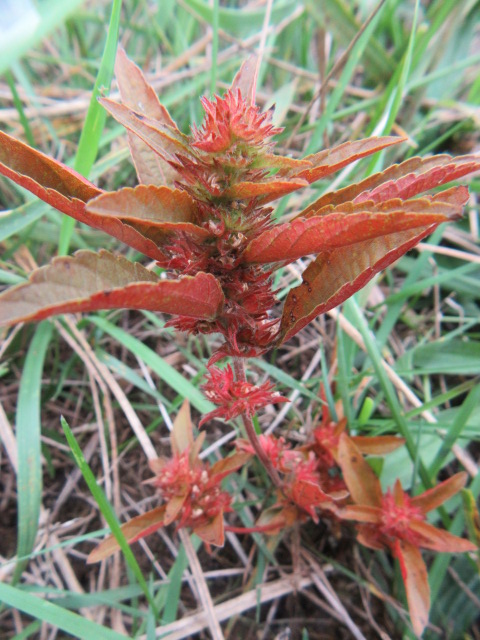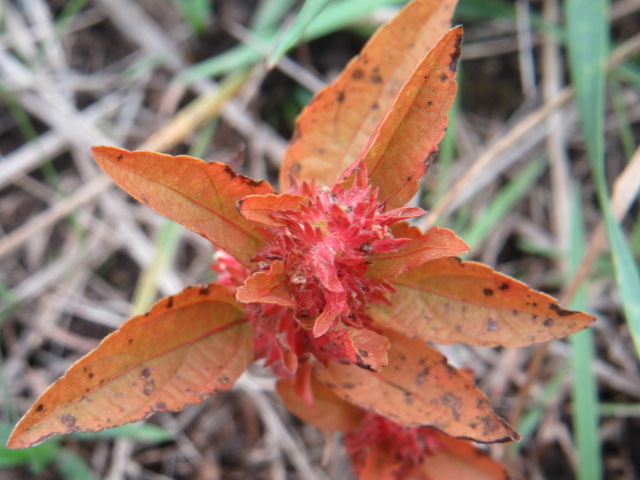
Acalypha gracilens (Slender Three-Seeded Mercury) on 10-24-21, #851-1.
Slender Three-Seeded Mercury. Three-Seeded Mercury, Shortstalk Copperleaf, Slender Copperleaf
Acalypha gracilens
ak-uh-LY-fuh grass-il-ENS
Synonyms of Acalypha gracilens (11) (Updated on 12-16-23 from Plants of the World Online): Acalypha gracilens var. delzii L.W.Mill. (1969), Acalypha gracilens var. fraseri (Müll.Arg.) Weath. (1927), Acalypha virginica Michx. (1803)(nom. illeg.), Acalypha virginica var. fraseri Müll.Arg. (1865), Acalypha virginica var. gracilens (A.Gray) Riddell (1853), Acalypha virginica var. gracilescens Müll.Arg. (1865), Acalypha virginica var. intermedia Riddell (1853), Acalypha virginica var. ovalifolia Riddell (1853), Acalypha virginica var. ramosa Riddell (1853), Acalypha virginica var. rhombifolia Riddell (1853), Acalypha virginica var. texana Riddell (1853)
Acalypha gracilens A.Gray is the accepted scientific name for this species. The species was named and described by Asa Gray in A Manual of the Botany of the Northern United States in 1848.
The genus, Acalypha L., was named and described by Carl von Linnaeus in the second volume of the first edition of Species Plantarum in 1753.
As of 12-16-23 when this page was last updated, Plants of the World Online lists 442 species in the Acalypha genus. It is a member of the plant family Euphorbiaceae with 228 genera. Those numbers could change as updates are made on POWO.

Distribution map of Acalypha gracilens from Plants of the World Online. Facilitated by the Royal Botanic Gardens, Kew. Published on the Internet; http://www.plantsoftheworldonline.org/. Retrieved on December 21, 2022.
The above distribution map for Acalypha gracilens is from Plants of the World Online. Areas in green are where the species is native and purple is where it has been introduced. The map on the USDA Plants Database is similar.
The map on iNaturalist shows where members have made observations. Anyone can join and it is a great website to confirm and share your observations. The maps on iNaturalist are continually updated as members post new observations.
THERE ARE SEVERAL LINKS AT THE BOTTOM OF THE PAGE FOR FURTHER READING AND TO HELP WITH A POSITIVE ID.

Acalypha gracilens (Slender Three-Seeded Mercury) on 10-24-21, #851-2.
As I was walking through the main hayfield on October 24 in 2021, I spotted this interesting plant with glowing coppery leaves. I took photos and identified the plant on iNaturalist as Acalypha gracilens. Normally, I don’t do any wildflower hunting after mid-October because we usually have a few frosts by then and there isn’t much going on. Common names for this species are Slender Three-Seeded Mercury. Three-Seeded Mercury, Shortstalk Copperleaf, Slender Copperleaf, and perhaps others.
Acalypha gracilens is a monoecious annual wildflower with deep taproots. It prefers open areas in forests, rocky prairies, low meadows, and roadsides. I found a few of these plants growing on the hill in the hayfield. The genus name, Acalypha, is a Greek word that refers to the nettle-like shape of its leaves. The species name, gracilens, is a Latin word that means slender or graceful.

Acalypha gracilens (Slender Three-Seeded Mercury) on 10-24-21, #851-3.
A lot of the descriptions of plant anatomy are somewhat complicated to understand and you need a glossary. I will attempt to describe it the best I can in layman’s terms…
This species grows either from a single stem or branches from the base growing to around 15 to 30” in height. The stems can be green or reddish-brown and have short, appressed hairs.

Acalypha gracilens (Slender Three-Seeded Mercury) at 4 1/4″ tall on 10-25-21, #852-1.
I went back the next day to get more photos of this plant and couldn’t find the same one. Luckily, I found a few more.

Acalypha gracilens (Slender Three-Seeded Mercury) on 10-25-21, #852-2.
The leaves grow in an alternate pattern along the stems, one leaf per node, and have short hairs that are turned inward facing the stem (antrorse pubescent). The leaves are fairly slender, lance-shaped, and taper to a point. They have two prominent lateral veins that run parallel to the midrib. Leaves are kind of dull green and turn a copper color in the fall.

Acalypha gracilens (Slender Three-Seeded Mercury) on 10-25-21, #852-3.
The inflorescence (flower stem), 8-9 mm long, has male (staminate) and female (pistillate) flowers. The female flowers are lower on the raceme while the male flowers are toward the tip. Female flowers are surrounded by toothed bracts with 3-5 teeth that are said to be antrorse pubescent (small hairs that point toward the stem)… The flowers are more obvious after flowering from May through October.
They produce 3-seeded fruit that are dispersed by explosive mechanisms that are possibly triggered by ants…

Distribution map for Acalypha gracilens in Missouri from the USDA Plants Database. Published on the internet at https://plants.sc.egov.usda.gov/home. Retrieved on December 30, 2021.
Hmmm… According to the Missouri Plants website, Acalypha gracilens is found mainly in the southeastern and east-central parts of Missouri. Zooming in on the USDA map for Missouri, it shows the species growing in a few counties scattered in the northern part and along the east and southeast part of the state. It seems the species has found its way to Pettis County where I live in the west-central part of the state. BONAP (The Biota of North America Program) shows it is present in every county in Missouri… Well, no map is perfect… All I know is that I found a few plants on the hill in the main hayfield/pasture in October in 2021…
NOW, it could be a similar species such as Acalypha monococca (One-Seeded Mercury) or Acalypha virginica (Virginia Copperleaf/Virginia Three-Seeded Mercury). I took photos of one plant that was identified as Acalypha virginica in 2022 on iNaturalist (Research Grade), but there wasn’t really any identifying features to prove that. It was growing along the old foundation (where my grandparent’s old home was) with a colony of Euphorbia dentata. So, I really need to find plants and take detailed photos to make a proper identification. Both Acalypha gracilens and A. virginica produce 3 seeds while A. monococca produce only one. A. gracilens and A. virginica are even more similar, but the “hairs” on the stems are different. A. virginica has hairs that are more appressed and spreading. I would note that one of the common names for A. monococca (the one used by iNaturalist) is Slender Three-Seeded Mercury. That is odd since that species only produces one seed… I flagged the species and explained A. monococca had only one seed, so they changed the common name to Three-Seeded Mercury. The seeds on all three species look somewhat different, so I think the seed, types of hairs on the stem, and shape of the leaves are key features to look at…
The summer of 2023 was very hot and dry, so I didn’t do much wildflower hunting. I didn’t see anything later in the season resembling this species…
As far as using maps go, the USDA Plants Database shows Acalypha gracilens is not present in Pettis County (where I live) or surrounding counties. BONAP just says it is present in the state without county data. BONAP and USDA both show A. monococca as being present in the county I live in and most of Missouri. The USDA map does not show Pettis for A. virginica but shows it present in surrounding counties. BONAP shows it present in Pettis and most of Missouri. Hmmm… The USDA gets its data from BONAP… The date on the BONAP maps is 2014… A LOT can change in 10 years. Let’s face it, data is based a lot on specimens collected and pressed many years ago and not current findings. The maps on iNaturalist are based on observations by its members and are continually updated. But, not many members have posted observations for these three species of Acalypha. My observation of A. gracilens was not agreed on, so it didn’t become Research Grade. Someone, however, did agree on my observation of A. virginica, but personally, I can’t tell by my photos how a positive ID could be made. It was windy and I couldn’t get good close-ups. Practice makes perfect… Controversial species are hard to get someone to agree which I why I normally take A LOT of photos.
So, the goal in 2023 is to find more Acalypha on the farm and take as detailed photos as I possibly can. Especially of the fruit and hairs on the stems… I have likely passed over them many times because it’s the flowers that always catch my eye. Flowers of these three species are definitely not eye-catching…
I have enjoyed photographing and learning about the many wildflowers growing on the farm and other areas nearby. I live on a small farm in Windsor, Missouri in Pettis County (Henry County is across the street, and Benton and Johnson aren’t far away). I have grown over 500 different plants and identified over 200 species of wildflowers (most have pages listed on the right side of the page). I am not an expert, botanist, or horticulturalist. I just like growing, photographing, and writing about my experience. I rely on several websites for ID and a few horticulturalists I contact if I cannot figure them out. Wildflowers can be somewhat variable from location to location, so sometimes it gets a bit confusing. If you see I have made an error, please let me know so I can correct what I have written.
I hope you found this page useful and be sure to check the links below for more information. They were written by experts and provide much more information. Some sites may not be up-to-date but they are always a work in progress. If you can, I would appreciate it if you would click on the “Like” below and leave a comment. It helps us bloggers stay motivated. You can also send an email to me at thebelmontrooster@yahoo.com. I would enjoy hearing from you especially if you notice something is a bit whacky.
FOR FURTHER READING:
PLANTS OF THE WORLD ONLINE (GENUS/SPECIES)
INTERNATIONAL PLANT NAMES INDEX (GENUS/SPECIES)
TROPICOS (GENUS/SPECIES)
FLORA OF NORTH AMERICA (GENUS/SPECIES)
WORLD FLORA ONLINE (GENUS/SPECIES)
WIKIPEDIA (GENUS/SPECIES)
USDA PLANTS DATABASE
MISSOURI PLANTS
iNATURALIST
WILDFLOWER SEARCH
NORTH CAROLINA STATE UNIVERSITY
GO BOTANY
LADY BIRD JOHNSON WILDFLOWER CENTER
MARYLAND BIODIVERSITY PROJECT
NOTE: The data (figures, maps, accepted names, etc.) may not match on these websites. It depends on when and how they make updates and when their sources make updates. Some websites have hundreds and even many thousands of species to keep up with. Accepted scientific names change periodically and it can be hard to keep with as well. Some of the links may use a name that is a synonym on other sites. In my opinion, Plants of the World Online by Kew is one of the most reliable and up-to-date plant databases and they make updates regularly. I make updates “at least” once a year and when I write new pages or add new photos but I do get behind. We are all a work in progress. 🙂